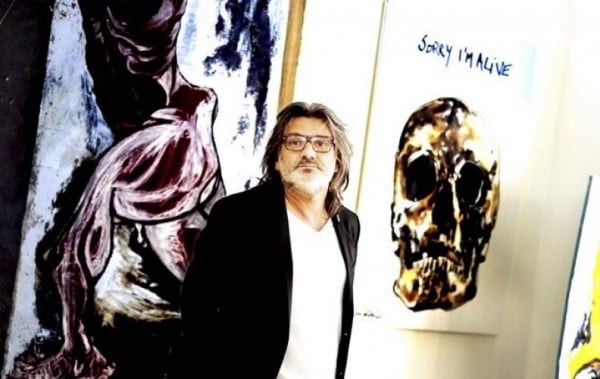People
Meet Liposuction Artist Ben Colibri Who Paints With Human Fat—Gross
His collectors reportedly include Nicolas Sarkozy, Hugh Hefner, and Ivana Trump.

Photo: via midilibre.fr
His collectors reportedly include Nicolas Sarkozy, Hugh Hefner, and Ivana Trump.

Rain Embuscado

Strange things happen in the art world all the time. Nonetheless, this took us all a little by surprise. French artist Benoît Maurin-Ducolibri, who works under the name Ben Colibri, creates art from real liposuction fat.

Liposuction fat.
Photo: Courtesy of Benoît Maurin-Ducolibri.
The self-proclaimed plastic arts painter revealed in an interview with the Daily Beast that he’s used human liposuction fat for 15 paintings and 10 sculptures. And yes, in the images above, that is Colibri tenderly holding a cylindrical bag of his beloved sculptural material for the camera.
“First, it arrives as hot liquid,” the artist said, describing his process. “Then you have to preserve it by freezing it, and it becomes even more bizarre. I cut some frozen slices that I then melt it into a liquid which becomes a medium like linseed oil, to which I add pigment and sealant. I can then paint.”

Liposuction fat art.
Photo: Courtesy of Benoît Maurin-Ducolibri.
His works range from macabre paintings of skulls to sculptures of chicken breasts and babies composed with the organic substance. And while the material is dark and unsavory (“Human fat stinks. When I melt it, it smells of death. It’s horrible.”), his handling of it is irreverent. Take, for example, his paintings of skulls, which are accompanied by written phrases like “Sorry I’m Cooking.”
Due to the nature of the material, it might come as little surprise that he’s apparently gotten instant fans. He’s had shows in the South of France, according to the story, and collectors of his work include Nicolas Sarkozy, Hugh Hefner, and Ivana Trump.
“It may come as a surprise to some people that models actually have liposuction,” he told the Daily Beast in a tidbit that gives his art a whole new dimension. “We don’t know this and assume them to be perfect, naturally. My girlfriends, who were models, were afraid of losing their jobs on the catwalks.”
“I don’t seek to criticize the fashion world of Western society,” he said, noting the works’ aspirations to social commentary, “but sometimes I just want to be able to stop the ‘fashion show’ and make us reflect upon who we are.”